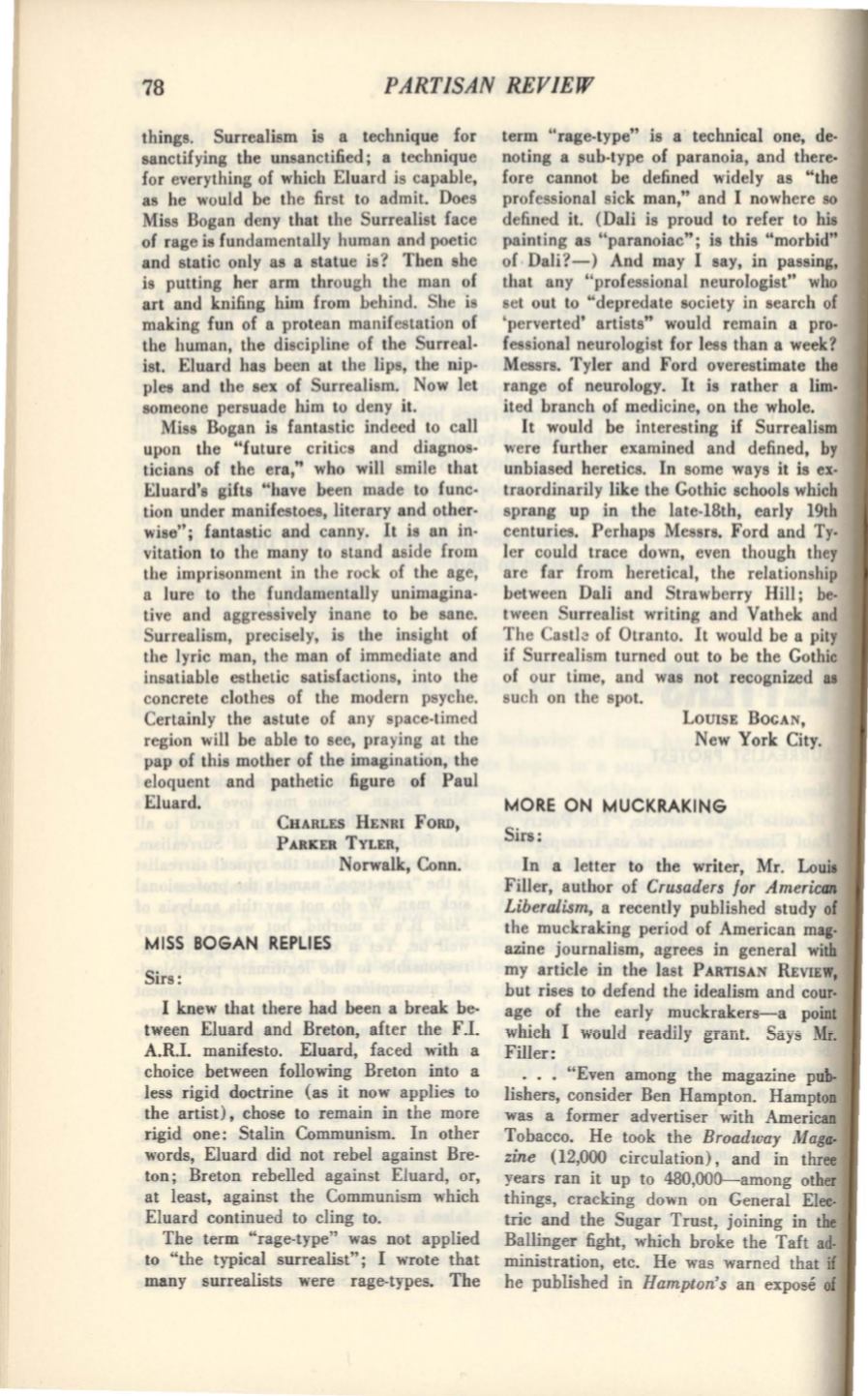
78
PARTISAN REVIEW
things. Surrealism is a technique for
sanctifying the unsanctified; a technique
for everything of which Eluard is capable,
as he would be the first to admit. Does
Miss Bogan deny that the Surrealist face
of rage is fundamentally human and poetic
and static only as a statue is? Then she
is putting her arm through the man of
art and knifing him from behind. She is
making fun of a protean manifestation of
the human, the discipline of the Surreal–
ist. Eluard has been at the lips, the nip–
ples and the sex of Surrealism. Now let
someone persuade him to deny it.
Miss Bogan is fantastic indeed to call
upon the "future critics and diagnos–
ticians of the era," who will smile that
Eluard's gifts "have been made to func·
tion under manifestoes, literary and other·
wise"; fantastic and canny.
It
is an in–
vitation to the many to stand aside from
the imprisonment in the rock of the age,
a lure to the fundamentally unimagina·
tive and aggressively inane to be sane.
Surrealism, precisely, is the insight of
the lyric man, the man of immediate and
insatiable esthetic satisfactions, into the
concrete clothes of the modern psyche.
Certainly the astute of any space-timed
region will be able to see, praying at the
pap of this mother of the imagination, the
eloquent and pathetic figure of Paul
Eluard.
CHARLES HENRI FoRD,
pARKER TYLER,
Norwalk, Conn.
MISS BOGAN REPLIES
Sirs:
I knew that there had been a break be–
tween Eluard and Breton, after the F.I.
A.R.I. manifesto. Eluard, faced with a
choice between following Breton into a
less rigid doctrine (as it now applies to
the artist), chose to remain in the more
rigid one: Stalin Communism. In other
words, Eluard did not rebel against Bre–
ton; Breton rebelled against Eluard, or,
at least, against the Communism which
Eluard continued to cling to.
The term "rage-type" was not applied
to "the typical surrealist"; I wrote that
many surrealists were rage-types. The
term "rage-type" is a technical one, de·
noting a sub-type of paranoia, and there–
fore cannot be defined widely as "the
professional sick man," and I nowhere so
defined it. (Dali is proud to refer to his
painting as "paranoiac"; is this "morbid"
of. Dali?-) And may I say, in passing,
that any "professional neurologist" who
set out to "depredate society in search of
'perverted' artists" would remain a pro–
fessional neurologist for less than a week?
Messrs. Tyler and Ford overestimate the
range of neurology. It is rather a lim–
ited branch of medicine, on the whole.
It
would be interesting if Surrealism
were further examined and defined, by
unbiased heretics. In some ways it is ex–
traordinarily like the Gothic schools which
sprang up in the late-18th, early 19th
centuries. Perhaps Messrs. Ford and Ty–
ler could trace down, even though they
are far from heretical, the relationship
between Dali and Strawberry Hill; be–
tween Surrealist writing and Vathek and
The Cast!<! of Otranto. It would be a pity
if Surrealism turned out to be the Gothic
of our time, and was not recognized as
such on the spot.
LoUISE BocAN,
New York City.
MORE ON MUCKRAKING
Sirs:
In a letter to the writer, Mr.
Louis
Filler, author of
Crusaders for Americtlll
Liberalism,
a recently published study of
the muckraking period of American mag–
azine journalism, agrees in general with
my article in the last pARTISAN REVIEW,
but rises to defend the idealism and cour–
age of the early muckrakers-a point
which I would readily grant. Says Mr.
Filler:
. . . "Even among the magazine pub–
lishers, consider Ben Hampton. Hampton
was a former advertiser with American
Tobacco. He took the
Broadway MagtJo
zine
(12,000 circulation), and in three
years ran it up to 480,000--among other
things, cracking down on General Elec–
tric and the Sugar Trust, joining in
the
Ballinger fight, which broke the Taft ad–
ministration, etc. He was warned that if
he published in
Hampton's
an expose of


